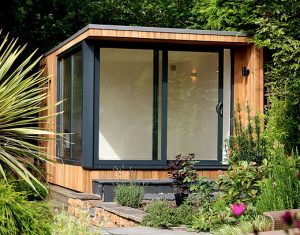Conservatories as detached garden extensions
No matter the size of a property, sometimes homeowners want a space that they can relax or escape in – a sanctuary away from the main property. As a result, detached garden room extensions that are located in the midst of a garden can be a great way of providing much needed space for loved ones to use and enjoy.
This can also be a great solution for homeowners who require extra space, perhaps to accommodate a growing family, but may not have the means to do so within the main house, perhaps because of architectural constraints or limited space within the property. Alternatively, they can work especially well for those who work from home as it can offer a place to work in isolation away from any domestic distractions.
Choosing to build an extension is an investment that should not be taken lightly, and as a result there are a variety of steps that should be considered to ensure the room achieves maximum longevity.
1) Design
 The aesthetics of the extension tend to be the first consideration of homeowners. This is generally a good place to start, but there are a few factors that should be thought through before picking the style of extension.
The aesthetics of the extension tend to be the first consideration of homeowners. This is generally a good place to start, but there are a few factors that should be thought through before picking the style of extension.
Detached extensions, if designed well can allow for a high amount of creativity with the old architecture of a house sitting comfortably against the modern design of a detached extension. Similarly a classical style extension can suit properties of all eras.
However, the style of the extension will invariably come down to who is going to use the extension. For example, if it is to be used as an additional space to enjoy the views of the garden then it is worth incorporating sliding doors that can be opened up to create a seamless space between extension and garden. If it is however going to be used as an additional bedroom for guests then it is imperative to ensure that adequate privacy is provided, perhaps by placing a roof lantern to gain sunlight but without compromising on privacy.
The ultimate thing to remember here is that an extension should be a balance between form and function. Here is a good reference site: https://www.conservatorypro.co.uk/glass-conservatory/
2) The practicalities of an extension
 It may sound obvious but the nature of these extensions mean that they are often vulnerable to the harsh conditions of all seasons – snow and hail, wind, rain and extreme sunlight to name a few! As a result, it is vital to invest in the right materials to ensure that the extension can cope with these fluctuating conditions and also to ensure that the room is usable all year round.
It may sound obvious but the nature of these extensions mean that they are often vulnerable to the harsh conditions of all seasons – snow and hail, wind, rain and extreme sunlight to name a few! As a result, it is vital to invest in the right materials to ensure that the extension can cope with these fluctuating conditions and also to ensure that the room is usable all year round.
The choice of material will make a huge difference, so speak to a designer or architect about which material is best suited to your needs. However, generally speaking timber can be a great insulator and often outperforms rival materials such as uPVC, and it can often last longer too.
It follows on from the above point, that the positioning of the extension can also impact how susceptible it is to the harsh weather conditions. South-facing extensions without any shelter tend to attract the most sunlight, and can obviously become warm in the summer months, and so careful consideration is required when it comes to glass and glazing.
3) Glass and glazing
If there isn’t any natural shade it can be hugely beneficial to apply a high quality film to the windows to reflect heat and the sun’s damaging ultraviolet rays – a primary cause behind fading carpets and furniture.
Ventilation is another crucial consideration for keeping glazed extensions cool. It is essential that air is able to flow through the building and that colder air can be drawn into the building. Consider the use of either roof vents, extractor fans, ceiling fans or air conditioning – especially if the extension is likely to be used during the day when the sun is at its hottest.
4) Insulation
Heating tends to be the main concern when designing an extension, but this needn’t be the case as there are a variety of options that are now available. Under floor heating is a popular option as it has the added benefits of being completely invisible within the building. Solutions are available as either “Wet” meaning piped water, or electric.
The choice of material can also make a huge difference in insulating the extension. Choosing glass with a low U-value will help to keep the heat in.
5) Planning permission
Depending on the size of the extension it may not be necessary to go through the lengthy planning permission process. However to avoid the process the project would need to fulfil the following criteria:
- No more than half the land around the original building can be covered by additions or separate buildings.
- That the maximum depth of a single storey rear extension is 3m for a semi-detached house and 4m for a detached house.
- That the maximum height of a single storey rear extension is 4m (measured to the ridge of roof system).
- That the maximum height of an extension that is within two metres of a boundary is 3 metres.
- That there are no verandas, balconies or raised platforms.
